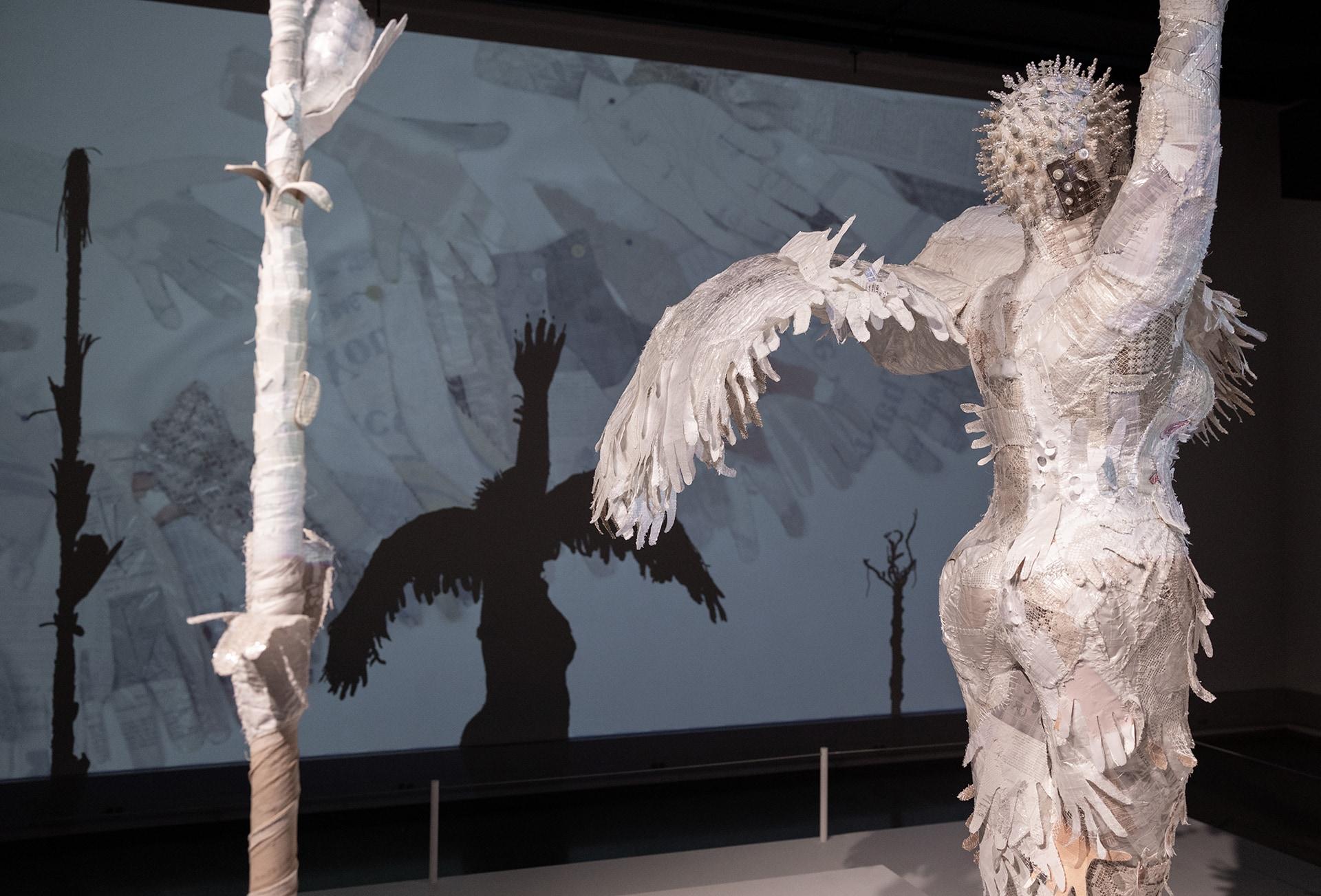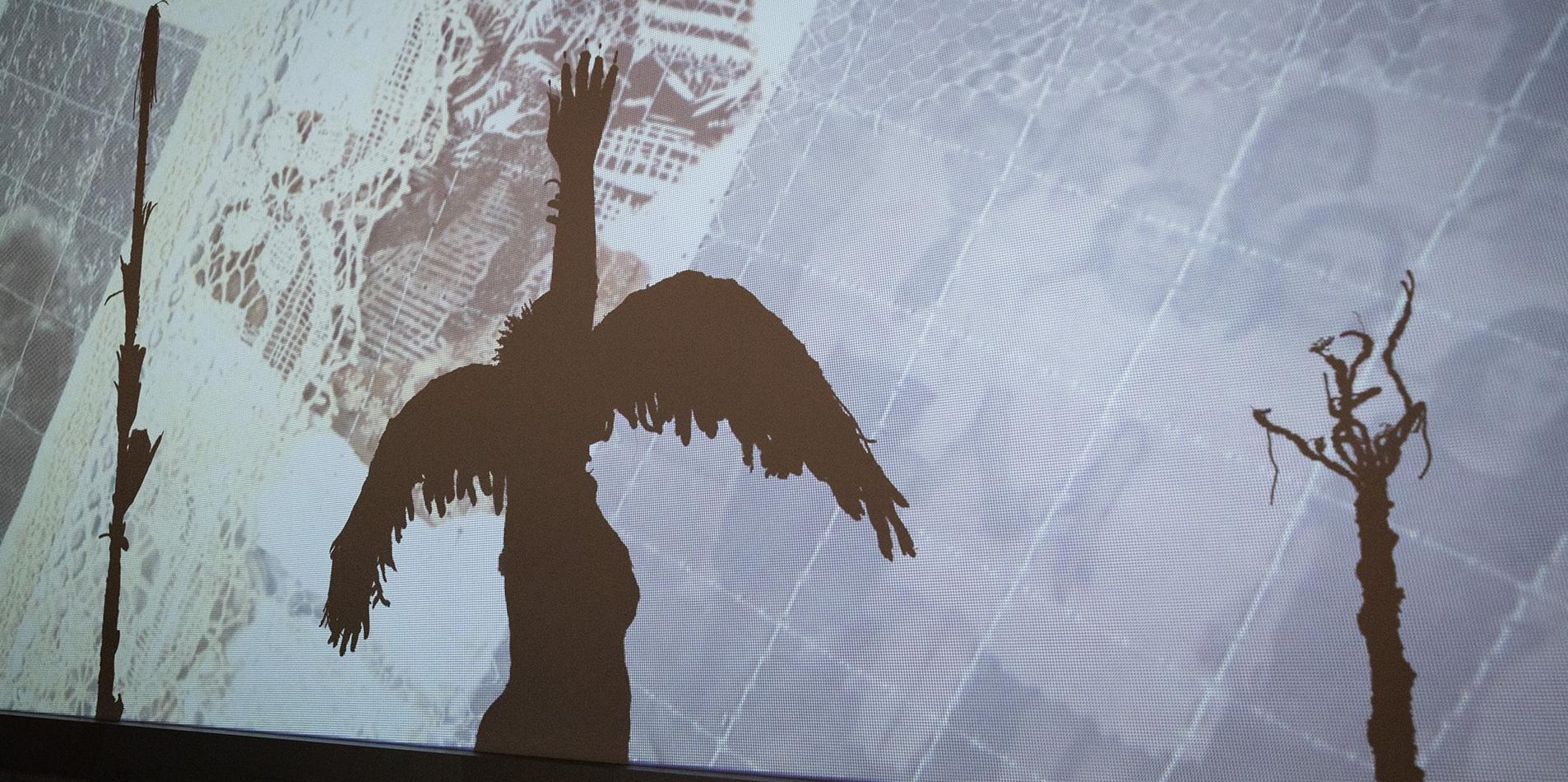By Steve Scarpa, Associate Director of Marketing and Communications
Video and photos by Andrew Melien, Digital Media Specialist
Over 500,000 sandhill cranes migrate every year to the Platte River in Nebraska. Artist Katharen Wiese, a Nebraska native and 2024 Yale MFA graduate, saw something more in this than a yearly natural event – she saw an analogy for the flight of African Americans to the North during the 20th century.
A local conservationist called this crane flight the Great Migration, the same term used by historians for the mass movement northward of African Americans between 1910 and 1970. Wiese’s family moved from Alabama to Nebraska in 1969 seeking opportunity.
Upon moving to Lincoln, Nebraska they faced a predominately white cultural environment. Her mother was often, like herself, one of very few students of color in any given classroom. Wiese was interested in the intergenerational implications of migration and adaptation as she began to explore crane migration and behavior at the Peabody. A core component of Wiese’s research was on cosmetic staining in cranes and other species using iron rich mud, a behavior sometimes called painting.
“I have been considering ideas of assimilation, adaptation, and belonging implied by painting, and the particular significance of these ideas in relation to black Nebraskans’ making space for themselves in predominantly white environments. How do we adapt to monocultural environments and how do we determine the meaning of our own adaptation?” said Wiese, who joined the museum as a Summer Art Fellow. This fellowship is co-sponsored by the Yale Peabody Museum and the Yale School of Art.

Wiese’s collection of sculpture and projections exploring these ideas, entitled A Great Migration, is on display at the Yale Peabody Museum throughout the fall. Admission to the Yale Peabody Museum is free.
“Wiese’s project explores the natural world, African American history, the concept of legacy, and the power of communal actions. A Great Migration offers incisive connecting threads that feel at home at the Peabody in exciting new ways,” said Kailen Rogers, Associate Director of Exhibitions.
The presence of a working artist reacting in real time to their scientific inquiry has added a new and welcome dimension to the Peabody’s work. Going back to the creation of the iconic mural The Age of Reptiles, in the 1940s, art and science have been an important part of the Peabody’s ethos. Wiese’s exhibition continues that long and robust tradition.
“Throughout this fellowship period, Wiese's insights—often shared in meandering conversations at the ends of long days—have changed how I view the potential of the renovated museum and my own work,” Rogers said.
We sat down to chat with Wiese about the genesis of her project, how she mined the Peabody’s collection for information and ideas, and what it means to art and science to exist side by side.
The following is a video of this conversation. Edited excerpts from the conversation are available below.
The following are edited excerpts from the conversation.
_________________________
A lot of your work engages with African American history and identity. What was your inspiration for your research on sandhill cranes with the Peabody?
In Nebraska, where I am from, about 500,000 sandhill cranes land along the Platte River in what some biologists call a great migration. I became really interested in this language and how it mirrored the language also used to describe African Americans moving from the South to the North.
My family moved from Alabama in 1969 to Nebraska. I was thinking about these other Nebraska families, Nebraska migrants, and their experiences of adaptations.
Sandhill cranes will dip their beaks in iron rich mud, and they'll paint their wings. Biologists believe this could be a way that they're trying to camouflage themselves. It could also be a way to look youthful, like juvenile cranes. It made me think about how African Americans and people of color also adapt in different environments.
What influences helped you to envision this piece of art?
I am excited by how A Great Migration synthesizes a space between engagement with scientific research, craft traditions, and African American history. Both in science and the arts, the labor of women is often underrepresented and undervalued, especially women of color.
This work is deeply influenced by matrilineal craft traditions like quilting, sewing, crochet, and beading. For example, I worked alongside the crochet artist Ellika Edelman, another African American woman, to make the bases for two of the sculptures. Additionally, all four of my great grandmothers were quilters. My grandmother sewed and crocheted. My mother makes beaded jewelry. All these women are in the work.
I have not drawn boundaries around what materials and practices are legitimate modes of participation in knowledge production. One of the key inspirations for this research was the oral history of quilt codes and how they helped African Americans navigate the Underground Railroad. One of those codes is called flying birds and it's a series of triangles each moving in the same direction. This made me imagine my own flying birds, a topic I explored in other works as well.
You engaged multiple audiences in the development of your fellowship project. How do you think the community engaged nature of the projects speaks to the idea of migration?
I was interested in engaging intergenerational audiences with the project. All of us have migration stories, sometimes across continents, sometimes across states and countries. I moved from Nebraska to New Haven, and I was thinking about this other Northern movement that I'm now a participant in.
One of the things that I've been doing is engaging visitors at the Museum. A lot of the sculpture and the video in my work includes hand tracings from museum participants.
There was a woman and her two daughters who all recently moved from London that spent 30 or 40 minutes doing crafts with us. They told me that the experience of meditating on their migration story opened a conversation for them about the move they just made. So, I think [this work] opens opportunities for a new space of listening.
I also worked with EVOLUTIONS students [in the Peabody’s afterschool program] who helped me make shadow puppets that were included in the film. It was fun to talk to them about where they were from and things they experienced on their own different trips. Some of the students I worked with were talking about airplane rides. Some of them were talking about moving to a different country where they didn’t speak the language.
Migration is something that we all experience in different ways. We are all a part of it.


How do you think the context of a museum like the Peabody, in contrast to an art museum where this would normally be seen, shifts the meaning of your work?
A natural history museum is a space where intergenerational audiences are asking questions about science, anthropology, and living creatures. Human history is also Natural History. We're all part of environmental systems. Those are all questions that I'm interested in.
I find more and more that the artists that I'm excited about are having bigger conversations about climate, about social practice, and about the world we live in. I think of my art as a way to engage with the world. It's sometimes a very solitary and private practice but there's always ways I build in research, engagement, and social practice.
My artistic practice is invested in using reclaimed materials and thinking about my own responsibility in the world. The Peabody is a good space to investigate those different intersections at different levels.
What does research mean to you as you start making a piece of art when you're engaging with a place like the Peabody?
Cranes are fascinating. I thought I knew what they were. The more I learned by doing research in the Peabody’s collections, seeing specimens, and speaking to ornithologists, the more I realized I really don't know who they are, or how their behaviors are motivated. That inspires me that they have a real culture, just like we have a culture.
I was thinking about the migration of cranes as being a direct metaphor with African American migration through the landscape. I had been thinking about their practice of painting as a kind of camouflage. One of the first things that happened when I came here is I met an ornithologist who asked me is it camouflage or is it something else that they're doing? And I realized their behavior is much more complex than I understood.
Could you tell me a little bit about your experience with the Peabody Summer Art Fellowship?
It was cool to kind of submit this ambitious multi-faceted project with collaborations, workshops, sculptures, and production. At every turn, I feel like Nicole (Palffy-Muhoray) and the Student Programs team were like, ‘Yeah, you should do that. We're going to support you doing that.’ I don't think it's very often you get like three months to just make things, and work on your practice, and think about community engagement with the level of encouragement that I've had. It's been a huge gift and I feel really grateful for it.
I'm excited to see other artists coming into the Peabody in the future and how they access the collections and the resources.
